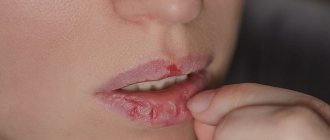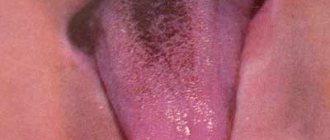There can be many reasons why lips stick together and the skin around the mouth dries out. When dealing with such a problem, it is very important to determine the source of its occurrence and eliminate it. Only after this the treatment will be successful and quick. You should not engage in independent treatment; it is better to trust professionals, since it is important to accurately diagnose and prescribe competent therapy.
Non-pathological causes
Various factors can provoke white plaque on the lips:
- insufficient oral care;
- an unbalanced diet when it does not provide the body with sufficient vitamins and minerals;
- wearing dentures;
- taking certain medications;
- depression;
- bad habits, in particular smoking.
To get rid of unwanted manifestations in such cases, it is enough to eliminate the provoking factor.
If the problem occurs only in the morning, most likely the white coating is dried saliva that flows out randomly during sleep. When such manifestations are observed occasionally, and the plaque itself does not have an unpleasant odor, there is no need to worry. The film will disappear after hygiene procedures.
Preventive actions
To minimize the risk of unpleasant symptoms and deterioration of skin condition, you must follow simple rules:
- eat a balanced diet;
- observe drinking regime;
- treat underlying diseases in a timely manner;
- protect skin from ultraviolet exposure;
- control your habits and actions - do not lick or bite your lips; make sure that the child does not do this;
- cope with stress;
- use hypoallergenic, high-quality cosmetics for lip care.
Chief author and editor-in-chief: Makarskaya S.E., 29 years of experience.
Last revision: 01/10/2019
Pathological causes
If plaque appears regularly even after oral hygiene, this may indicate a more serious pathology, namely:
- diseases of the gastrointestinal tract;
- scarlet fever;
- respiratory tract diseases;
- lichen planus;
- stomatitis;
- diabetes mellitus, in which you constantly feel thirsty;
- exacerbation of herpes infection.
An undesirable symptom may also appear in the morning due to dental diseases (caries, periodontal disease).
Candidiasis: manifestations of infection and its danger
Separately, it is worth highlighting such an infectious disease as candidiasis. Fungi of the genus Candida are present in almost every organism. Under favorable conditions (decreased immunity, taking antibiotics, oncology, hormonal changes during pregnancy, menopause, etc.), they are activated and cause candidiasis of the oral mucosa. The disease most often affects infants and older people.
One of the main signs of the disease is a white, loose coating on the tongue and lips. It may also cover the inner surface of the cheeks, less commonly affecting the palate and gums. The plaque is easily scraped off, the tissue underneath turns red and sometimes bleeds. Other symptoms of candidiasis:
- unpleasant taste;
- dry mouth;
- burning sensation;
- formation of cracks on the lips and redness in the corners of the mouth;
- pain and difficulty swallowing;
- discomfort with normal tongue movements.
The disease can occur in acute and chronic form. The first of them is more common. The second can manifest itself in smokers, as well as in carriers of HIV infection. As each form of the disease progresses, other undesirable symptoms may appear.
If the acute form of candidiasis is not treated, it will become chronic. In this case, the patient feels severe discomfort. In places where plaque is localized, wounds appear that bleed and fester. Thrush quickly spreads to other parts of the mouth, making it difficult to chew food. The infection eventually affects the pharynx and tonsils. Then it descends into the lungs, gastrointestinal tract, liver and causes irreparable harm to them.
Why do lips become sticky?
Lack of vitamins
The cause of this mouth problem is an acute deficiency of vitamin substances in the body. This condition negatively affects the condition of the skin. It can dry out and lose elasticity. Most often, negative effects are observed with a lack of the following vitamins:
- Vitamin A or retinol. An acute lack of this vitamin in the body makes itself felt by certain unpleasant signs, which include: loss of elasticity of the epidermis, increased dryness.
- Vitamin E or tocopherol is responsible for the normal regulation of water balance in the epidermal layer. If this substance is contained in the body in minimal quantities, unpleasant symptoms such as peeling, roughness, dryness and stickiness of the skin occur.
- B vitamins are the main link in the metabolic processes that occur in the cells of the epidermis. If these elements are not enough, the lips become cracked, inflamed, rashes, dryness and stickiness appear on them.
- Vitamin C is very important for healthy looking skin. With a lack of this vitamin, collagen synthesis in the dermal cells is disrupted. This is characterized by such signs as dryness, pallor, loss of elasticity.
If vitamin deficiency is diagnosed, any medications should be prescribed only by a doctor, especially if this concerns children.
Allergy
When in contact with various irritants, stickiness may appear on the lips due to the development of an allergic reaction. At the same time, such a problem can be provoked by either a single contact with an allergen or prolonged exposure to it. The most common irritants include:
- Ultraviolet radiation, intense wind. Often the lips stick together in the spring of those people who do not use protective cosmetics.
- Dental substances that are used by doctors to fill teeth.
- Ingredients that make up lip cosmetics. Especially if the lipstick or balm is expired.
- Using toothpaste with a high fluoride content increases dryness and stickiness of lips.
- Citrus products, salty, spicy foods.
- Smoking. For many heavy smokers, substances present in cigarettes react with the skin, causing unpleasant symptoms.
If an allergy is diagnosed, exclusion of the potential irritant and treatment with antihistamines will be necessary.
Other reasons
Other reasons for this condition include constant lip licking, especially in strong winds or cold. As a result, redness, dryness, and the formation of pale yellow or grayish scales appear on the epidermis. After their removal, a red border is visible. Many experts are convinced that if a person constantly licks his lips, he is susceptible to frequent stress, so in this case, a mandatory component of complex therapy is to reduce the negative impact of stressful situations.
The habit of holding various objects in the mouth is often observed in children than in adults. The child gets acquainted with the world around him, constantly tries to explore the surface, taste toys and other objects. This is fraught with the penetration of bacteria into microdamages on the skin, the development of an inflammatory process and unpleasant symptoms, including increased dryness and stickiness of the skin.
Sometimes sticky lips are a sign of an infectious disease:
- infectious - bacterial, candidiasis or herpes cheilitis;
- infectious dermatitis.
Other reasons for a sticky mouth include:
- diseases of the gastrointestinal tract;
- general dehydration of the body;
- anemia;
- diseases of the urinary system;
- development or exacerbation of diabetes mellitus;
- pathology of the thyroid gland.
If these are symptoms of disease, a thorough diagnosis must be carried out before prescribing treatment.
Localization Features
The cause of plaque can be determined by taking into account its location.
| Localization | Most likely causative factors |
| Corners of the mouth |
|
| Outer lips |
|
| Inner lips |
|
A sticky coating on the surface of the lips in the morning indicates a pathology of the stomach or esophagus.
How is treatment carried out when plaque appears in the oral cavity?
To prescribe effective treatment, the doctor must first determine why plaque appears on the lips. The faster and more accurately he makes a diagnosis, the easier the therapy will be. Treatment will differ in each individual case. A universal technique is to rinse the mouth with soda and potassium permanganate.
Treatment of candidiasis can be local and systemic. Suitable therapy is selected taking into account the stage of development and form of the disease. Local treatment of the affected areas is carried out using antifungal and antiseptic drugs - sprays, rinses, gels, etc.
Systemic treatment of candidiasis is carried out in the chronic form of the disease and its spread to other organs. It involves taking special polyene antibacterial drugs, which are active against most fungi and some protozoa, or antimycotic substances. The following remedies are often prescribed:
- "Nystatin" is a polyene antibiotic characterized by moderate toxicity;
- Fluconazole is a highly effective antimycotic drug;
- "Nizoral" is an antifungal agent that copes with candidiasis in a few days.
An addition to the main therapy can be rinsing the mouth with decoctions of sage, chamomile, and yarrow. To eliminate an undesirable symptom, it is important to adjust your diet, drink enough fluids, and humidify the air in the room. It is also necessary to sanitize the oral cavity and constantly maintain its hygiene at a high level.
On average, treatment takes three weeks. It is carried out until the symptoms disappear completely and then extended for another week.
Types of lip diseases
Cheilitis can be divided into several categories. Here are their names:
- exfoliative;
- glandular;
- meteorological;
- actinic;
- atopic;
- eczematous;
- candida.
In addition, there are other diseases that are not related to cheilitis. Therefore, dryness, peeling, crust formation, and a red border near the lips are causes for serious concern and a reason for examining the entire body.
Atopic cheilitis
Atopic cheilitis is sometimes called allergic because it is caused by various irritants. The cause of the disease can be food or cosmetics. It turns out that the allergen affects the skin of the lips both from the inside and outside.
The disease manifests itself as inflammation of the red border of the lips. The skin becomes dry and peels. Cracks, itching and burning may occur.
Most often, children and adolescents suffer from lip allergies. Often it is the only symptom of neurodermatitis or atopic dermatitis.
Glandular cheilitis
Glandular cheilitis is an inflammation of the salivary glands, which are located on the surface of the mucous membrane of the lips.
The disease is more common in men over 50 years of age and is characterized by the following symptoms:
- noticeable red dots appear on the lower lip;
- copious secretion of saliva from the inflamed glands, the appearance of “dew drops”;
- dryness, cracks and erosion;
- Bacteria can enter the irritated canals, leading to the formation of pus.
There are primary and secondary forms of glandular cheilitis. The primary disease develops due to genetic predisposition. Secondary lip disease can be caused by lupus, oral leukoplakia, or lichen planus.
Meteorological cheilitis
People have to deal with this disease all the time. Standard chapping, which more often appears in winter, is meteorological cheilitis.
The first sign of the disease is a feeling of skin tightness. In advanced cases, it turns red, dries out, and becomes covered with cracks. This lip inflammation can be treated at home. It is enough to isolate yourself from harmful factors, moisturize and nourish the skin until it is completely restored.
Eczematous cheilitis
Eczematous cheilitis is one of the manifestations of eczema - an inflammatory process of a neuroallergic nature, which most often manifests itself on the face or dry areas of the body. Usually the disease is accompanied by constant dryness and redness. In advanced cases, the skin begins to peel off and become covered with blisters.
The disease often affects the tissue around the lips, so the patient may develop a red border, as in the photo on the right. This area of skin is constantly itchy and itchy.
If the disease is chronic, the symptoms are less pronounced. But in this case, seals appear on the skin.
Actinic cheilitis
Many people believe that lips need to be protected only in winter. Therefore, it is at this time of year that people stock up on moisturizing and nourishing balms to relieve dry and itchy lips. However, delicate skin must be protected not only from frost, but also from the burning sun.
With increased sensitivity to ultraviolet radiation and prolonged exposure to open areas, actinic cheilitis forms. His symptoms are standard:
- dryness, flaking;
- redness and swelling;
- compaction of individual areas.
If you do nothing, your lips become crusty. This is how the body tries to somehow protect the vulnerable part of the face. This symptom appears less frequently than others.
In advanced cases, ulcers, erosions and small compactions occur around the oral cavity. This condition is precancerous.
Exfoliative cheilitis
The exfoliative form of the disease occurs due to stress and disturbances in the functioning of the immune system. Genetic predisposition plays a major role. If your parents had this disease, there is a high risk that you will develop it too.
Exfoliative cheilitis on the lips occurs in two forms: exudative and dry. In the first case, you can observe the so-called yellow lips (pictured). A dense crust of this shade forms on the skin.
The yellow crust is easy to tear off; this process does not cause much discomfort. There are no erosions or other damage under the crust.
In the dry form of the disease, a crust also forms on the lips, but not yellow, but a lighter shade. The patient is concerned about dry skin, which explains the name of the disease. There is a desire to lick your teeth, but it is better not to do this: you can cause an infection and provoke more irritation.
Candidal cheilitis
If the lips are red, inflamed and crusted with a cheesy coating of white or yellowish color, it means that the cause of these symptoms is candidiasis. If you clean off the plaque, inflamed areas of skin will be exposed. How such a lip disease manifests itself is shown in the photo.
The disease occurs due to the excessive development of the Candida fungus. The pathogen lives on the human mucous membranes constantly, but the active development of the fungus begins only under favorable conditions, which include:
- decreased immunity due to past illnesses or lack of nutrients;
- long-term use of antibiotics;
- a sharp change in climate to a hotter and more humid one.
Fungal inflammation of the lips begins externally, but can spread to the internal tissues of the oral cavity, thus leading to candidal stomatitis.
Lip cancer
Many of these diseases, if not given proper attention to their treatment, lead to cancer. Perhaps this is the most terrible disease that can affect the lips and oral cavity.
At first, the symptoms of cancer are unremarkable. The lips will turn red and there will be slight inflammation. The skin may become dry and cracked. If the patient moisturizes and nourishes the affected tissues, but the lips remain sore for several weeks, he should sound the alarm and consult a specialist. Later, ulcers and lumps may appear.
Usually, if treatment is started correctly and on time, the cancer recedes completely. Only in rare cases are relapses possible.
There is another disease that is compared to cancer - Manganotti syndrome. The disease manifests itself in the form of a noticeable ulcer on the lip, which is precancerous. However, due to the fact that in most cases the syndrome still develops into a tumor, it is more often classified as oncological diseases.







